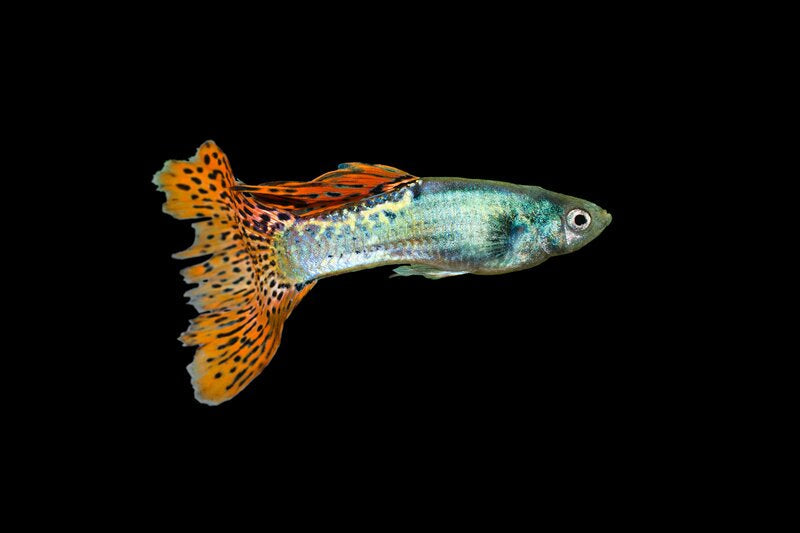Table of Contents
Guppy fish are a popular choice among aquarists, admired for their stunning colors, playful behavior, and ease of care. However, just like with any other pet, guppy fish come with their fair share of misconceptions and myths that often leave hobbyists confused and misinformed. To ensure the health and happiness of your guppy fish, it's crucial to separate fact from fiction and understand their actual needs, behaviors, and characteristics.
In our in-depth article, we'll address many common misconceptions about guppy fish and replace them with expert-backed knowledge. With guidance from Splashy Fish, a leading provider of high-quality freshwater fish, shrimp, aquatic plants, and premium fish food, we'll help you build a strong foundation of accurate information essential for a successful and enjoyable guppy fish experience.
Myth 1: Guppy Fish Are Low-Maintenance and Require Minimal Care
While it's true that guppy fish are relatively easy to care for compared to some other aquarium species, the notion that they are a "set and forget" pet is completely false. Proper care and maintenance of an optimal environment are essential for the health and well-being of your guppy fish. Key factors such as water quality, temperature, tank size, filtration, substrate, and a balanced diet must all be considered and regularly maintained.
Guppy fish thrive in stable water conditions with a temperature range of 72-82°F and a pH level of 6.8-7.8. Monitoring and maintaining these parameters are essential to provide a suitable habitat for your guppy fish. Regular water changes, proper filtration, and vigilant attention to your fish's needs will ensure their health and happiness in your aquarium.
Myth 2: Guppy Fish Can Live in Small Bowls or Vases
The widespread misconception that guppy fish can be kept in small, low-capacity bowls or even vases has spread, perpetuating the false belief that these fish can live in cramped conditions without issue. The truth is, guppy fish require adequate space to swim, explore, and interact with their surroundings.
A minimum tank size of 10 gallons is recommended for a small group of guppies, with 15-20 gallons being ideal, as it allows for increased swimming space and improved water quality. A larger tank will better accommodate your guppy fish's needs and provide a more stable and healthy environment for them to thrive.
Myth 3: Guppy Fish Can Survive on a Diet of Only Flakes
Many people think that feeding their guppy fish only flake food is sufficient to meet their nutritional requirements. While high-quality flake foods can indeed provide an excellent base for their diet, guppy fish require a variety of food sources to achieve optimal health, growth, and coloration. As omnivorous creatures, guppy fish benefit from a varied diet that includes live or frozen foods, plant-based sources, and flakes or pellets.
Supplement flake foods with options like brine shrimp, mosquito larvae, daphnia, bloodworms, and vegetables such as peas and spinach. Providing a diverse diet will help ensure your guppy fish receive all the essential nutrients they need to stay healthy and maintain their vibrant colors.
Myth 4: Guppy Fish Do Not Require Tank Mates
While guppy fish are known for their peaceful nature, it is a misconception that they do well in solitude. In reality, guppy fish are social animals and thrive in the company of other guppies or compatible species. Keeping guppies such as blue tarzan guppy, koi guppy in small schools or groups, typically with a ratio of two females to one male, ensures they can express their natural behaviors and interact positively with their tank mates.
When choosing companions for your guppy fish, it is essential to consider size, temperament, and compatibility. Avoid aggressive or predatory fish, instead opting for other peaceful community species such as endlers, platies, mollies, or small tetras to create a harmonious tank environment.
Myth 5: Guppy Fry Can Safely Coexist with Adult Fish
While adult guppies are social creatures, it's a mistake to assume they'll always be friendly toward their offspring. Adult fish, including guppies, are known to eat their fry if given the chance. Therefore, it's crucial to separate the guppy fry from the adults using a breeding box or a separate nursery tank until they are large enough to coexist safely.
Additionally, providing ample hiding spots in the tank through plants and decorations can offer protection to the guppy fry and minimize predation risks within the aquarium.
Myth 6: Guppy Fish Will Not Overpopulate the Tank
Guppy fish are infamously prolific breeders, leading many aquarists to underestimate their reproductive capabilities and their potential impact on the aquarium environment. Guppies can reproduce rapidly, quickly causing overcrowding issues that can lead to decreased water quality, stress, and illness among the fish.
If you're not prepared to deal with an increasing population, consider keeping only male guppies or opting for a mixed gender guppy tank with a higher female-to-male ratio. Implement strategies to control the guppy fish population, such as removing pregnant females or setting up a separate breeding tank.
Build the Perfect Home for Your Guppy Fish, Debunked Myths and All!
Armed with accurate information and a firm understanding of guppy fish care, you can now confidently dispel common myths and misconceptions, ensuring your guppy fish receive the best care possible. Creating a thriving guppy fish haven takes dedication, attention to detail, and a foundation built on facts – all of which will reward you with an engaging and vibrant aquatic experience.
Splashy Fish partners with you on this journey, offering beautiful guppy fish and a wide range of high-quality aquarium supplies to meet all your guppy fish care needs. We're dedicated to helping you establish and maintain a successful guppy fish environment based on fact, not fiction. Browse our selection and expert resources today, and let us support you in creating a happy, healthy, and myth-free world for your guppy fish!



























